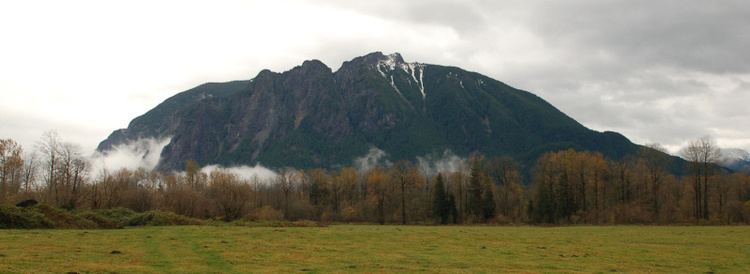Topo map USGS Mount Si Prominence 75 m Easiest route Hiking | Elevation 1,270 m Parent range Cascade Range | |
 | ||
Similar Little Si, Rattlesnake Ridge, Tiger Mountain, Squak Mountain, Mount Adams | ||
Mount si north bend washington
Mount Si (pronounced sigh) is a mountain in the U.S. state of Washington. It lies on the western margin of the Cascade Range just above the coastal plains around Puget Sound, and towers over the nearby town of North Bend. The mountain was named after local homesteader Josiah "Uncle Si" Merritt. It was made famous in the show Twin Peaks, which was filmed in North Bend.
Contents
- Mount si north bend washington
- Map of Mt Si Washington 98045 USA
- Day 19 mount si north bend washington
- Oceanic Plate VolcanoEdit
- In local native legendEdit
- References
Map of Mt Si, Washington 98045, USA
Only about a 45-minute drive from Seattle, the mountain is a favorite outdoor destination for residents of Puget Sound. Between 80,000 and 100,000 hikers visit the mountain annually. The land is owned by the state of Washington and has been designated a Natural Resources Conservation Area.
The 4-mile (6.4 km) long Mount Si trail climbs a total of 3,500 feet (1,100 m) reach to the summit ridge. The summit of Mount Si can then be reached by an exposed scramble, class 3, up the north side of the summit block which is known as the "Haystack."
Day 19 mount si north bend washington
Oceanic Plate VolcanoEdit
Mount Si is a remnant of an oceanic plate volcano and the rocks are highly metamorphosed.
In local native legendEdit
Mount Si figures prominently in a Prometheus story from the Snoqualmie tribe. According to the story it is the dead body of Snoqualm, the moon. Snoqualm had ordered that a rope of cedar bark be stretched between the earth and the sky. But Fox and Blue Jay went up the rope and stole the sun from Snoqualm. Snoqualm chased them down the cedar rope, but it broke and he fell to his death. Fox then let the sun free in the sky and gave fire to the people. A face like Snoqualm's is visible on the rocks near the summit.
